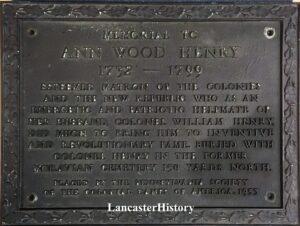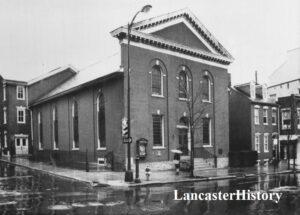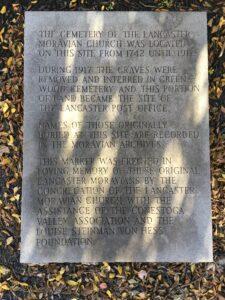Honoring Ann Wood Henry
First Historical Plaque in Lancaster County to Honor a Woman
Today marks 69 years since the dedication of a plaque erected in memory of Ann Wood Henry (1732-1799) on October 26, 1953. The LancasterHistory object collection contains a number of historic bronze plaques – some placed by the Lancaster County Historical Society (forerunner to LancasterHistory) as well as others placed by various individuals, businesses, or organizations to mark important places, people, or events in and around the county. Mounted to the sides of buildings or placed on stone tablets along roadways, these plaques were sometimes given to the Historical Society for safekeeping when a building was demolished or a roadway widened even if the plaque did not originate with the Historical Society. One such plaque that found its way into our collection is the Henry plaque, created in 1953 by the Pennsylvania Society of the Colonial Dames of America as a memorial to Ann Wood Henry, wife of Colonel William Henry and the first woman in Pennsylvania to hold public office.

The plaque reads:
MEMORIAL TO ANN WOOD HENRY 1732-1799. ESTEEMED MATRON OF THE COLONIES AND THE NEW REPUBLIC WHO AS AN ENERGETIC AND PATRIOTIC HELPMATE OF HER HUSBAND, COLONEL WILLIAM HENRY, DID MUCH TO BRING HIM TO INVENTIVE AND REVOLUTIONARY FAME. BURIED WITH COLONEL HENRY IN THE FORMER MORAVIAN CEMETERY 150 YARDS NORTH.
PLACED BY THE PENNSYLVANIA SOCIETY OF THE COLONIAL DAMES OF AMERICA, 1953
Ann Wood Henry – Pennsylvania’s First Female Public Official
Born in Burlington, New Jersey, Ann Wood was the great-great-granddaughter of George Wood, an early Quaker settler in Darby, Pennsylvania. She married William Henry (1729-1786), a successful gunsmith, engineer, soldier, politician, and inventor from Lancaster in 1756. He served in the Continental Congress from 1784 until his death in 1786 and as treasurer for Lancaster County; a position filled by Ann Wood Henry upon his death for the rest of his term and for several years thereafter. Since Henry and his family were members of the Moravian Congregation at Lancaster, Ann was buried in the Lancaster Moravian Cemetery.
The Lancaster Moravian Church and Cemetery
According to the website of the Lancaster Moravian Church, the church building was located at 30 West Orange Street at the intersection of Orange and Market Streets from its founding in 1746 until 1967 when the congregation moved to 1460 Eden Road. When the original building was torn down in 1967, the plaque honoring Ann Wood Henry was given to the Lancaster County Historical Society. The site is now the location of the Lancaster Parking Authority.

The cemetery of the Lancaster Moravian Church was located on the east side of Prince Street, north of Marion Alley; approximately 150 yards north of the church on West Orange Street as noted on the Ann Wood Henry plaque. That area is now occupied by the U.S. Post Office building located at the corner of North Prince and West Chestnut streets. A concrete plaque on the parking lot behind the building commemorates the site of the cemetery.
In 1917, the cemetery was relocated to Greenwood Cemetery in the southern end of Lancaster City. As part of the reinternment, several stone markers were placed at the new location, including one memorializing William and Ann Wood Henry as well as their son Benjamin West Henry.

The plaque reads:
THE CEMETERY OF THE LANCASTER MORAVIAN CHURCH WAS LOCATED ON THIS SITE FROM 1742 UNTIL 1917.
DURING 1917 THE GRAVES WERE REMOVED AND INTERRED IN GREENWOOD CEMETERY AND THIS PORTION OF LAND BECAME THE SITE OF THE LANCASTER POST OFFICE.
NAMES OF THOSE ORIGINALLY BURIED ARE RECORDED IN THE MORAVIAN ARCHIVES.
THIS MARKER WAS ERECTED IN LOVING MEMORY OF THESE ORIGINAL LANCASTER MORAVIANS BY THE CONGREGATION OF THE LANCASTER MORAVIAN CHURCH WITH THE ASSISTANCE OF THE CONESTOGA VALLEY ASSOCIATION AND THE LOUISE STEINMAN VON HESS FOUNDATION.
The Plaque Ceremony Honoring Ann Wood Henry
An article that appeared in the Lancaster Sunday News on October 18 with the headline “First Plaque To A Local Woman Will be Dedicated” provides important details about the plaque and the upcoming dedication ceremony:
First historical plaque every erected in Lancaster County in honor of a woman will be dedicated on October 26 by the Lancaster County Society of Colonial Dames in cooperation with the Pennsylvania Society. Honoring Ann Wood Henry, prominent local woman in Colonial History, the memorial tablet will be unveiled at 11 a.m. by Miss Elizabeth D. Steinman. Ceremonies will take place in front of the Moravian Church, 30 W. Orange St., where the plaque will be located on the outside church wall.
Mrs. Henry and her family were members of the church when their residence was located on the site of the present Central Market Building. According to Dr. Herbert Beck, president emeritus of the Lancaster County Historical Society, who has been active in arranging with the Colonial Dames for the erection of the plaque, Ann Wood Henry was the outstanding matron of Lancaster Colonial days. Wife of Col. William Henry, renowned gunsmith and first man to apply steam to navigation in 1763, she assisted him as superintendent of Arms of the Continental Army and she succeeded him as treasurer of Lancaster County. Born in 1732, she was of Quaker descent and the great-great-granddaughter of George Wood, first Quaker settler in Darby.
With Miss Steinman of the Lancaster Society will be Mrs. Thomas H. Stites of Nazareth, a direct descendent of Ann Henry. Also taking part in the ceremonies will be Mrs. James I. Wendell of Pottstown, president of the Pennsylvania Society of Colonial Dames, and Mrs. John H. Lawson, Philadelphia, a member of the Society’s national historic activities board.
The Legacy of Ann Wood Henry
Ann Wood Henry was a remarkable woman. The first woman to hold public office in Lancaster County and in Pennsylvania, she was also played a key role in running the Henry household while her husband held various leadership positions in commercial, legislative, and military spheres. The couple and their 13 children were reportedly deeply involved in the Moravian church as well.
While plaques and statues remind us of the contributions of both men and women, they do little to promote change or improve perceptions. Ann Wood Henry was much more than an “energetic and patriotic helpmate” who “did much to bring him to inventive and revolutionary fame.” As we mark the 69th anniversary of the dedication of this particular plaque we best honor the legacy of Ann Wood Henry by recognizing the dignity and accomplishments of all women throughout history, in our families, and in our communities by action and by example.
From Object Lessons
